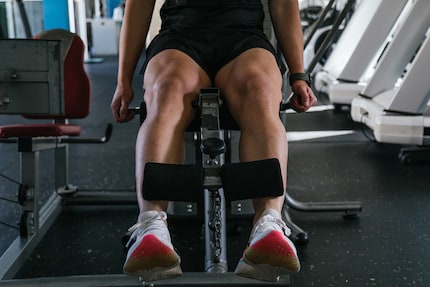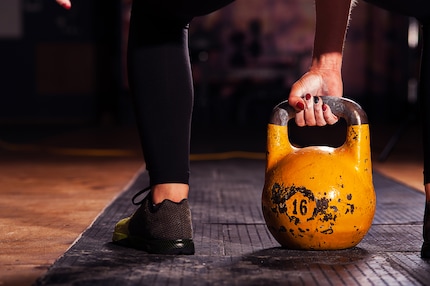
Background information
Strength training: muscles don’t count reps
by Claudio Viecelli

Muscles don’t count. That goes for reps and sets. Your muscles react to the mechanical and metabolic stress you put them under. Nothing more, nothing less.
Our muscles were developed via evolution to enable us to interact with our
environment. They store energy and can generate power. All they want to
do is rotate load around the joints. They don’t count the number of
reps or the number of sets you do as part of strength training.
A set is the number of repetition cycles you complete. Like the number
of reps, there are numerous training recommendations for the number of sets to achieve maximum muscle hypertrophy and strength. They range from two to six sets [1–3].
Hypertrophy means an increase in the cross-sectional diameter of muscle fibres. The term
volume load was introduced to assess and compare
strength training logs, calculating the load × number of
reps × number of sets. Working on your
biceps with a 10 kilo dumbbell and doing three sets of 12 reps
equals a volume load of 360 kilos.
Based on this approach, I take it that the goal of training is
hypertrophy. So we can assume that you’d want to increase the mass of one of the
most valuable tissues in the body: muscle. So
what is more effective for hypertrophy: one or multiple sets? How would you
show which is more effective in a scientific experiment?
In 2010, Burd et al. [4] investigated the link between
protein build-up in muscles from strength training using one and three sets in
eight young men experienced in strength training. The participants’
individual legs were randomly allocated to two groups (one set or three sets). The training
consisted of a leg extension that both
groups completed at 70% 1 RM until they were completely exhausted. The duration
of a rep was two seconds (one second concentric, one second eccentric). The one
set group completed 14 ± 2 reps, while the
other group managed 14 ± 1, 11 ± 1 and 9 ± 1 for sets one, two and three
respectively. The volume load was 942 ± 97 kg and 2183 ± 154 kg for both
groups. The stress duration was significantly different for the two
groups: 34 ± 3 seconds and 84 ± 3 seconds. Five hours after strength training,
there was increased protein build-up in both groups. However, the effect was stronger in the
group doing three sets. After 29 hours, protein build-up in the one
set group had returned to its original level. The level remained increased in the other group
even after 29 hours.

Has this study conclusively answered my question? No, because
the design isn’t valid to establish the effectiveness of one
or more sets. So what is behind the observed
increase in protein build-up? Is it due to the longer stress duration or the
increased physical work? Because no clear link can be made to one of the factors
, this kind of study design isn’t valid to answer the question of the right number of sets.
In another study, Burd et al. [5] carried out a similar study on 15 young
men with strength training experience. This time, the participants’ legs
were allocated to three groups:
The rest period between the sets was three minutes and the duration of a rep was
two seconds. The following volume loads and stress durations were measured per set for
each of the three conditions:
stress duration: 27.1 ± 1.85 seconds
Protein build-up was measured at the four and 24 hour marks after strength training. A
considerable increase in protein build-up was recorded in all of the groups after four hours of strength training,
while the effect was more noticeable in the two groups which trained
to exhaustion. 24 hours after strength training, only the group that trained to exhaustion at 30%
1 RM recorded significantly higher levels compared to the
other two.
The interesting thing about both studies is how the stress duration is viewed. In
both studies, protein build-up was still significantly increased between 24 and 29 hours
after strength training in the groups with longer stress
durations. So it looks like stress duration clearly has a major
impact. But because both physical effort and cumulative
stress duration are significantly different in studies that looked at the effectiveness
of one set compared to multiple sets, their conclusions
should be taken with a pinch of salt.

As suggested in my last article looking at animal [6]
and human models [7], we know the fatigue and strength profiles of
different motor units. Garnett et al. [7] showed that type S motor units in human calf muscles lose less
than 15% strength after 150 seconds. FR units
were found to lose more than 18% of their strength. However, the biggest
loss of strength was in FF type motor units at between
37% and 100%.
From the aforementioned studies on metabolism and fatigue in muscles, we can
deduce the stress duration that results in a robust anabolic reaction in muscles.
Units are recruited according to the size principle, initially
type S motor units, followed by FR type units and finally
FF type units. The metabolic fatigue of FF type units takes around
120 seconds, maximising the FF recruitment time integral (the stress
duration). This maximises
time at full recruitment.
Opting for a high training load (>85% 1 RM) immediately recruits all motor
units. If the stress duration at maximum
effort is only 20 seconds before putting the weight down, this
means that FF type motor units have experienced metabolic stress of 20
seconds. However, this doesn’t mean that type
FF units have been completely fatigued. This would require an effective
stress duration six times longer and multiple
sets to be completed. The inefficiency and high biometric
stress on the joints are clear to see.
Complete recruitment of all motor units can also be achieved
via fatigue, but not all units are initially recruited at a
training load of less than 85% 1 RM. However, over the course of the exercise, units
with a high recruitment threshold (types FR and FF) are added until
all motor units are recruited. The effective stress duration should then be maximised at full recruitment.

There has not yet been a scientifically valid study design that has
conclusively answered the question. As studies that examine the
impact of differing physical work (different numbers of sets and/or
reps) on protein build-up always change
multiple variables (physical work and stress duration), we can’t draw any
clear conclusions about any observed effects. I’d also
like to make it clear that there’s no scientific evidence to support the
conclusion that multiple sets automatically result in a stronger anabolic reaction
compared to one set. A muscle doesn’t have an internal
counter and it doesn’t care about the number or sets we do. It reacts to the physical and
metabolic stress it’s subjected to, while metabolic stress
is weighted more.
Cover image: Shutterstock
Molecular and Muscular Biologist. Researcher at ETH Zurich. Strength athlete.
Interesting facts about products, behind-the-scenes looks at manufacturers and deep-dives on interesting people.
Show all